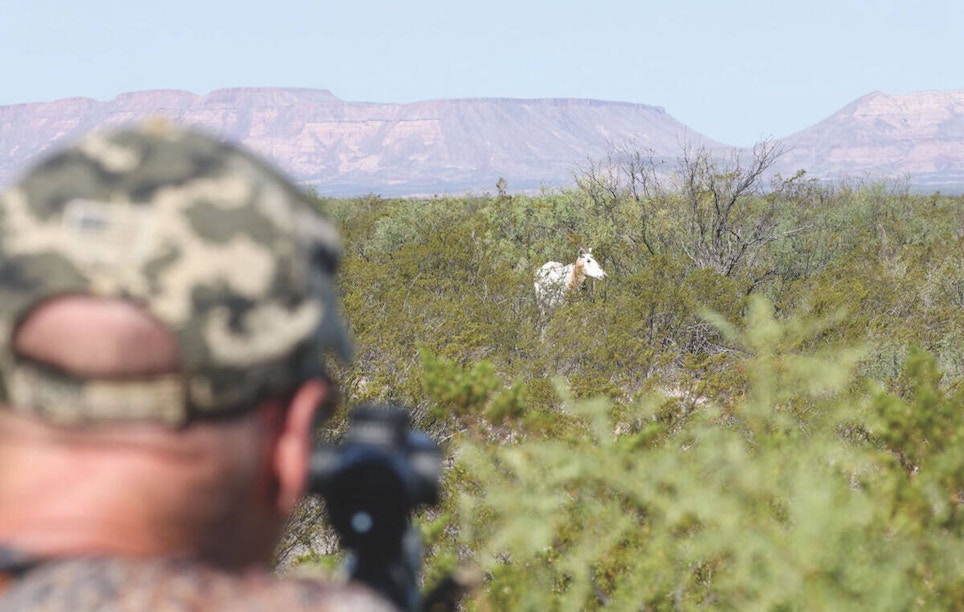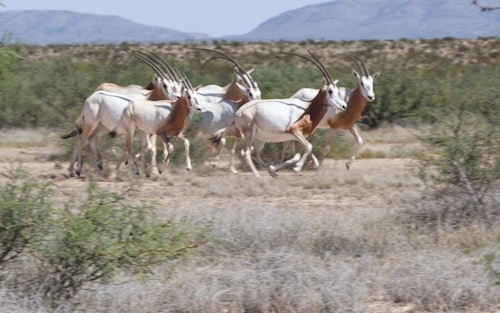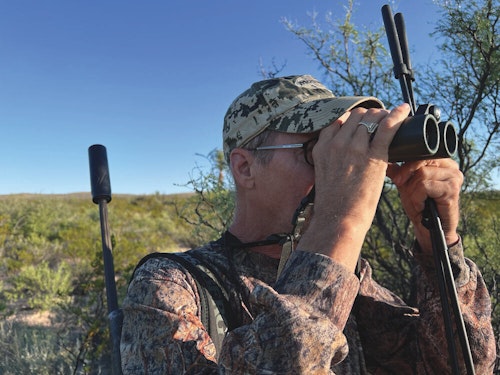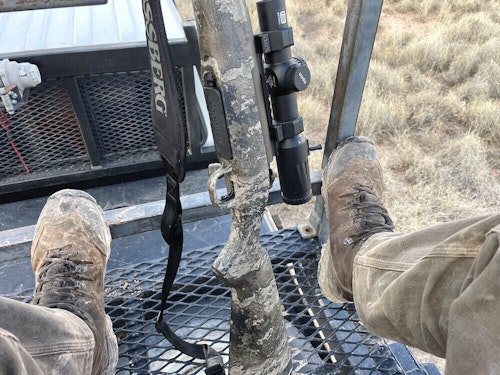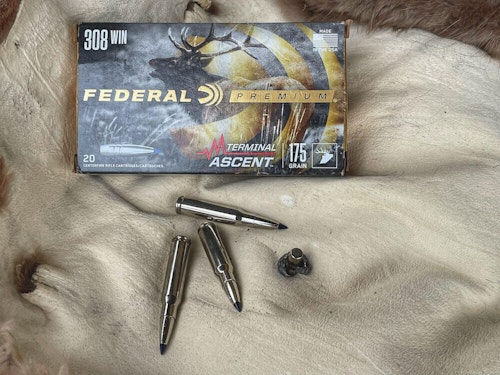We left the southwest Texas ranchero shortly before sunrise with only three hours to hunt before making the trek back to Midland where we would catch our flights home. It was day four of a three-day hunt and I was facing the possibility of returning home without punching my scimitar-horned oryx tag — and without all of that delicious table fare.
Friend and outfitter Steve Jones eased his well-worn Dodge one-ton truck up to a vantage point where we had a panoramic view of the undulating landscape — Santiago Mountain an ever present beacon to the northeast that had helped me keep my bearings during the past three days as we navigated the rutted two-tracks that dissected the expansive O2 Ranch, a half-hour south of Alpine. Jones is owner of Backcountry Hunts (www.backcountryhunts.com) and has been guiding hunters in pursuit of all sorts of critters in Texas and New Mexico since the mid-1980s — elk, mule deer, whitetails, turkeys, mountain lions and a variety of exotic big game, such as the oryx we were hounding.
One of the largest cattle operations in the Trans-Peco region during the late-1880s, the O2 Ranch encompasses 272,000 acres — and 70,000-plus acres of that expanse was our playground, where oryx are plentiful and sightings commonplace. Getting close enough for a shot can be another matter. These large members of the antelope family are watchful and skittish — quick to escape when they feel even slightly threatened. Getting within range typically means spotting them from the truck, making a huge circle to get the wind right, slipping into range undetected and (the tricky part) identifying a mature bull.
This was a safari-style hunt but nothing like a ride in the park. We’d drive from one area to the next and then let our optics do the lion’s share of the walking — taking to foot if we spotted a potential bull we wanted a closer look at. On the last full day of the hunt my guide and I covered 8.3 miles on foot according to my iPhone app — just over 22,000 steps — in 90-plus-degree heat. All of which ended in blown stalks or gender miscalculation.
And therein lies another challenge. Bulls and cows both carry impressive spiral horns, those of the females matching and often exceeding those of the males. If anything, the horns of the females are often longer, while those of the males are slightly thicker. And while either is legal to shoot, most outfitters — including Mr. Jones — prefer that their clients target the bulls.
Extinct But Doing Fine
Scimitar-horned oryx, of course, are not native to the Lone Star State, where they are hunted as an exotic species. Also known as the Sahara oryx, they were once widespread across North Africa. Prized for their horns, meat and leather, they were over-harvested, and in 2000 the species was declared extinct in the wild and put on the IUCN Red List of Threatened Species. Now they exist in their home range only in special preserves — not so in Texas where they run wild in respectable numbers. By some estimates Texas is home to approximately 12,000 scimitar-horned oryx, as large a number of these animals as have ever existed in Africa by some estimates.
This final morning of the hunt, I had an entourage. Steve’s No. 1 guy, Dave Callaway, was my wing man and best buddies Linda Powell from Mossberg and Ron Spomer, freelance scribe/photographer extraordinaire, were along to offer needed encouragement. I’d been following Dave around for the past three days and I was the only hunter in camp without an oryx on the ground. He wasn’t alright with that.
We’d wasted a good chunk of the morning sneaking up on what turned out to be a small band of cows and calves, and we were back at the truck licking our wounds. “There’s another group of them at the base of that hill over there,” Steve said. I followed his gaze and could make out a string of white and tan bodies moving through the scrub brush. They’d seen the truck and while they weren’t spooked they were keeping a close eye on us. A stalk would eat up what little time we had left to hunt, but we had little choice.
We were closing ground on what was beginning to look like another group of cows and calves when Dave tapped me on the shoulder. “To your right,” he whispered. I looked over just in time to see a lone oryx walk through an opening in the brush 150 or so yards away and just as quickly disappear. I hustled to my right where Dave was already deploying the shooting sticks. I eased the rifle into its cradle as the oryx walked into the next narrow opening. “It’s a bull!” Dave had made the identification. The oryx was quartering away and already half-way through my shooting lane. All I could think to do was give him a coyote bark … which stopped him in his tracks.
I tugged the trigger and I heard the distinct “whomp” of the bullet hitting home. And just like that, it was over. The bull was down and still. We walked over and I ran my hand over its thick spiral horns and severely scarred body — the bull was clearly an old, solitary warrior. Now it was time to make quick work of field dressing and loading the bull so we could get back to camp and pack our gear.
Gearing Up
This was my first time pursuing Texas scimitar-horned oryx and it was also my introduction to hunting with a suppressed rifle. Both produced beyond expectations. The oryx hunt was more challenging and therefore more rewarding than I’d imagined and hunting with a suppressor added so many unexpected advantages — and dispelled so many preconceived notions about these devices.
The following are some of the key gear items I took on this trip and why. Carefully consider the wants and needs of your customers and help them make sound decisions when gearing up for an out-of-state hunting adventure.
Predator Vs. Prey
The last thing you want is an unhappy customer — one who has made a poor decision when it comes to selecting a specific rifle for a specific task. As a shooting sports retailer, you’ve seen it all and can help by asking the right questions and sorting through the options until, together, you find the best solution.
As I mentioned, ours was a safari-style hunt, which meant we spent a good deal of time being jostled about in a truck in rough terrain, driving from vantage point to vantage point trying to locate a good bull — exiting the truck quickly when we did. And that’s why I decided to go with a rifle that’s the very definition of a short, rugged and maneuverable truck gun — Mossberg’s Patriot Predator bolt action chambered in the versatile .308 Win.
The compact Predator features Mossberg’s twin-lug, push-feed machined-steel action, fed from a lightweight polymer flush four-round box magazine. Its standard-contour, free-floating 24-inch barrel has a 1:8 twist rate, straight-edge fluting and is threaded for the addition of a suppressor. As with every Patriot rifle, it features Mossberg’s patented Lightning Bolt Action user-adjustable trigger with a 2- to 7-pound range of adjustment.
Linda Powell, director of media relations, says that sometimes she wonders if Mossberg incorrectly named the rifle. “The name really is a misnomer in a sense, because you think of it as a predator rifle but that’s not entirely the case. It’s a predator in itself — and you’re the predator hunting the prey. Really, it’s ideal for hunting anything from predators to big game. It’s very versatile and easy to carry and maneuver because of its compact size.”
The Predator is dressed in True Timber Strata camo — a digital pattern that blends in with a variety of different terrains, complimented by a barrel and receiver coated with a Cerakote Patriot Brown finish — a handsome rifle to be sure. For more info, visit www.mossberg.com
Taming the Beast
As I mentioned, this oryx hunt was my introduction to hunting with a suppressed rifle and, lucky for me, Brandon Maddox, CEO of Silencer Central, was on hand to school me on the process of obtaining and using these devices.
Silencer Central has been in the business of providing hunters and shooters with suppressors for more than 15 years — offering its customers a more simplified process for safely and legally obtaining a suppressor. It streamlines the silencer buying process by taking care of all the ATF paperwork, its expert staff walking the buyer through the process and via its satellite locations in all 42 silencer-legal states delivering the unit directly to the buyer’s door. It’s the perfect avenue for firearm buyers or firearms retailers who don’t want to bother with the paperwork.
Maddox says there are several compelling reasons why suppressors make good sense when hunting. “The obvious benefit is hearing protection — you don’t need to wear ear plugs when you’re hunting,” he said. “When people hear that they say, ‘Oh, it would just be easier to wear ear plugs.’ But there are so many circumstances when you have ’em in when you don’t need ’em and don’t have ’em in when you need ’em.” Maddox points out that it’s not just the shooter’s ears, but making sure you’re protecting the ears of those around you as well.
The reduced sound signature also means you’re less likely to spook animals. “I was in a situation during this hunt where I saw someone shoot and miss, and the oryx didn’t run off nor did the other animals around it,” Maddox said. “So there’s the benefit that you might get an additional shot that you wouldn’t get with a non-suppressed gun.”
Another benefit is recoil reduction — which is similar to using a muzzle brake. “This means you can typically use a higher caliber than you otherwise would,” Maddox said. “A lot of people “caliber down” [because of recoil] but with a suppressor you can use the caliber you want.”
For our hunt, we were equipped with the Banish BackCountry Centerfire Rifle Suppressor, specifically designed for hunting and is rated up to .300 Rem. Ultra Mag., with sound reduction of 30dB. Utilizing a 1.375×24 universal mount, the Banish Backcountry is a direct-thread suppressor designed to eliminate any extra weight associated with a muzzle device method of attachment, but it is also available with an optional muzzle brake attachment. It features optional direct thread mount sizes and 100% high-quality titanium construction, including the mounts. The fully welded Banish BackCountry is 5.5 inches long, has a 1.6-inch diameter and weighs just 7.8 ounces without the mount/9.4 ounces with the direct thread mount. For more information, visit www.silencercentral.com
The Name Says It All
Only when you stuff your favorite hunting rifle with the best premium ammunition will you reap the full benefits of its accuracy and terminal performance potential. Fortunately, there is no shortage of high-quality factory ammo options out there for the discerning predator hunter. Federal’s Terminal Ascent is a good example — the ammo maker’s answer to one bullet for all hunting applications.
Federal Ammunition’s Terminal Ascent’s match-grade bonded bullet construction delivers deep penetration on close targets, while its patented Slipstream polymer tip helps flatten trajectory and initiates expansion at velocities 200 fps lower than comparable designs for long-range proficiency. The bullet’s long, sleek profile offers an extremely high ballistic coefficient and its AccuChannel groove technology improves accuracy and minimizes drag and wind drift. Its copper shank and bonded lead core retain weight for deep penetration at any range. Terminal Ascent is available in a full selection of long-range hunting cartridges ranging from 6.5 Creedmoor to .300 Win. Mag. For more information, visit www.federalpremium.com
